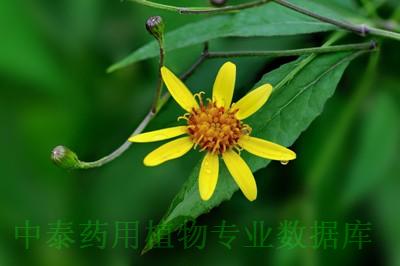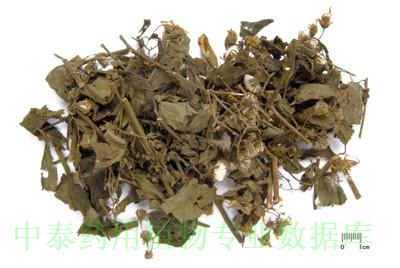| [English Name] | Climbing Groundsel Herb | |
| [Chinese Name] | 千里光 | |
| [Pinying Name] | Qianliguang | |
| [Latin Name] | Senecionis Scandentis Herba | |
| [Genera] | Compositae | |
| [Efficacy] | Antipyretic drug | |
| [Pictures] | Plant picture | Drug picture |

|

|
|
| [Alias] | ||
| [Source] | ||
| [Plant morphology] | ||
| [Distribution] | ||
| [Gathering and processing] | ||
| [Characteristics] | ||
| [Ecology] | It grows in hillside、open forest、forest side、road side and grassland beside ditch. | |
| [Chemical composition] | ||
| [Pharmacological activities] | ||
| [Clinical trial] | Qianliguang (Senecio) 1 pediatric exogenous cough: Dry qianliguang 25-50g water decoction,3 times a day, oral administration 30-50g each time, 3 days for a course oftreatment, within 3 years old children are in the limit of 10-20g. Treated 130cases, 118cases were stopped cough in 1-3days (90.8%), 10 cases were stoppedcough in 4-6days (7.7%), 2 cases were over a week (1.5%) [1]. 2 neonatus impetigo: The observation group were 38 cases, pick andclean up the fresh qianliguang 250g, and the whole stool of baifanshu 250g,boiling in 2500-3000ml water for 10-15min, remove slag, pour into a pot, coolingto 39 -42℃. Hold the neonatus’s head and neck, body, the other hand scrubbingthe head and face with a disinfect kerchief several times. Then soak theneonatus’s whole body into the medicine juice, make the head out of the water,use the disinfect kerchief scrubbing the unsoaked part for 10-15 min. Dry andcomfortable clothes are needed after the medicine bath. Construe 3 days, 1-2times a day. 38 cases in the control group, use the traditional method, disinfectionthe surface and surrounding skin of the impetigo with 75% alcohol(disinfection the surrounding skinof the broken burst part, or it has strong irritation),absorb the fester withdisinfection cotton swab, then wipe longdanzi, and give antibiotic follow thedoctor’s advice. Results: the total effective rate was 89.47% in the observegroup, while the control group’s total effective rate was 68.42%, the observegroup was better than the control group (P<0.01) [2]. 3 conjunctivitis, trachoma, keratitis: qianliguang (dry grass) 10000g,pengsha(borax) 38.2g, pengsuan(boric acid) 99.2g, sodium chloride 48.0g,hydroxyl ethyl benzene 5.0g, injection water add to 10000ml. Make theprescription as a light brown transparent eye drops, treatment 780 cases ofconjunctivitis, trachoma, keratitis, every 2-4h drops a time, each time 2-3drops, continuous a week. Results: symptoms disappeared or significantlyimproved in 608 cases, the total effective rate was 78% [3]. 4 Acute eczema: 450 acute eczema patients were randomly dividedinto treatment group and control group, 225 cases respectively, give theqianlima mixture (qianliguang, machixian 100g respectively) and 3% boric acidsolution to treat a course. Results: the total effective rate of treatmentgroup was 96.4%, the control group was 66.2%, the curative effect havesignificant difference in the 2 groups (P<0.05) [4]. |
|
| [Properties] | ||
| [Medical and other Uses] | ||
| [Dosage] | ||
| [Cautions] | ||
| [Traditional usage] | 1.Acute infection like carbuncle, phlegm and erysipelas 2.Ulcerative carbuncle 3.Reddish eyes with swelling and pain 4.Chronic ulcer on lower limbs 5.Scald and burn 6.Chronic eczema 7.Tinea manus, tinea capitis;Tinea boils8.Venomous snake bite 9.Chilblain 10.Acute infection of urinary tract 11.Sore and swollen throat 12.Acute appendicitis and enteritis 13.Hemorrhoid 14.Menorrhagia, metrorrhagia 15.Syphilis | |
| [Toxicological studies] | ||
| [Pharmaceutical preparations] | ||
| [References] |
[1] Dong Liang, Yang Xiyuan. The clinical efficacy observation of qianliguang.modern medicine,2002,18(6):498 [2] Luo Jinhua. Qianliguang, baifanshu in treatment of neonatalimpetigo clinical observation. Anthology of medicine, 1999, 18(5):802 [3] Li Mingfen qianliguang eye drops in the development andclinical application. The hospital preparation, 2001, 10(12):34 [4] Huang Rengong maxima mixture for topical treatment of acuteeczema 450 examples curative effects observation of traditional ChineseMedicine Journal, 2004, 3(6):34. |
|